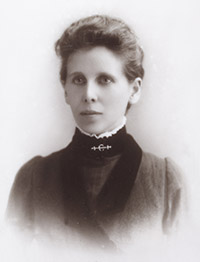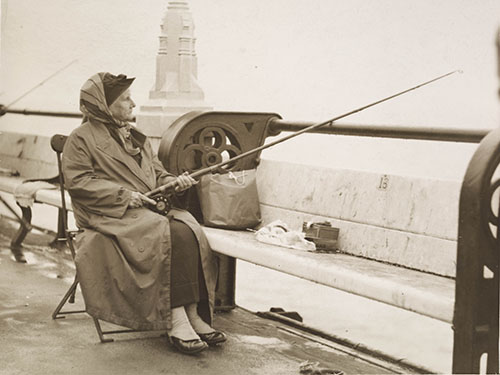
Portrait of Christina Livingston made three days before her marriage to Albert Edmund Broom © Museum of London
Christina Broom (née Livingston, 1862 – 1939) was a lone female London photographer of the Edwardian age and during World War One. Her achievements are all the more remarkable considering her small physical stature and the floor length dresses and elaborate hats she was obliged to wear at that time while lugging around cumbersome photographic equipment. Broom made a living out of postcards and also selling news images to the press. Lord Roberts and Queen Mary were among her great admirers, which helped to gain her often exclusive access to places like the Royal Mews and Wellington Barracks where she enjoyed carte blanche to shoot at will. The result was hundreds images of London’s streets and people during the early decades of the 20th Century.
In 2014 the Museum of London acquired a huge collection of Broom’s work which – along with objects lent by the Her Majesty and others – form the basis of Museum of London Docklands’s main show for this year: Soldiers and Suffragettes: the Photography of Christina Broom. Curated by Anna Sparham, it opens today, 19 June and runs until 1 November. Entrance is free.
The content of this exhibition falls into four areas: soldiers and suffragettes, as the title tells us; and then there are the post cards and sports images, largely the Boat Race. From the historian’s viewpoint, the postcards tell us much about streets, vehicles, costume and architecture. If, like me, you are deeply interested in Edwardian London, this is milk and honey. But the emotional appeal of this show resides with the suffragettes of the pre-War era and the soldiers of World War 1. For the time, these photos are incredibly informal and relaxed. One senses a clear bond of trust between the subjects and photographer. This removes from them the anger, fear and bitterness that one is inclined automatically to associate with war and with protest, delivering a massively poignant and nostalgic effect. It’s very moving indeed, making us appreciate all the more the achievements and sacrifices of our ancestors from not so long ago.

The Prisoners’ Pageant, including key members of the WSPU Emmeline Pethick-Lawrence, Sylvia Pankhurst and Emily Wilding Davison, themselves former prisoners, 23 July 1910 © Museum of London.

The Oxford rowing team at the University boat race, with photographer Alexander Korda at the water’s edge, Putney, 1911 © Museum of London
In addition to these workaday pictures – her best – there are also interesting historical subjects: royal and aristocratic portraiture, funerals, coronations and the like. Special mention must go to Christina’s daughter Winnie who did all the film processing and printing, a very specialist job indeed back then. There are on show some of her notebooks of chemical formulae and so on. Winnie’s lab was based in the coal cellar of their Fulham home and she was known to produce over 1,000 prints of an evening while Christina went out for a well-earned game of whist.
This is a superb exhibition which I am sure will help to build Christina Broom’s reputation as a Great in the history of photography, masterful at her craft, dedicated to it and a wonderful talent.

